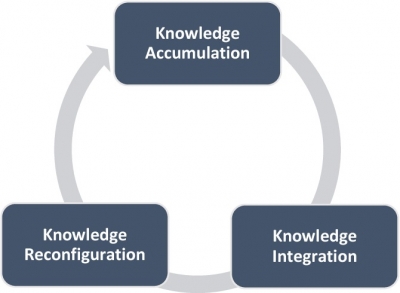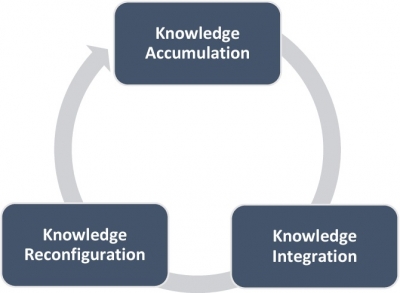Knowledge, with its wide classifications, can be classified into individual and collective knowledge. Executives recruit followers based on their individual knowledge, which refers to the individual’s skills, prior knowledge, and proficiencies (sometimes referred to competencies).
Collective knowledge, on the other hand, has been defined as “organizing principles, routines and practices, top management schema, and relative organizational consensus on past experiences, goals, missions, competitors, and relationships that are widely diffused throughout the organization and held in common by a large number of organizational members”(1). Thus, collective knowledge is part of the executive’s protocol and comes fairly naturally at the higher echelons of the organization.
Executives may share Thomas Davenport and Laurence Prusak’s concern that concludes that if executives cannot inspire their followers to share their individual knowledge with others, then this individual knowledge is not valuable to the organization (2). Individual knowledge can, therefore, become a valuable resource by developing an organizational climate of openness for members to exchange their ideas and insights.
Executives must create a climate of trust and openness for individuals to share individual knowledge. New technologies drawing on social-software systems through sharing individual knowledge around the organizations can positively contribute to create collective knowledge. Therefore, executives should build an atmosphere of trust and openness and use technology to convert individual knowledge into valuable resources for their organization to close the performance gap and help organizations prosper.
Knowledge also can be classified using individual, social, and structured dimensions. Executives can categorize followers based on their human knowledge, which focuses on individual knowledge and manifests itself in individuals’ competencies and skills. This form of knowledge comprises the skills gained by individual experiences, and learned as rules and instructions formulated by executives for followers to use as a guide.
Social knowledge, on the other hand, is categorized as individual knowledge that is shared so it can become collective knowledge. Executives can use structured knowledge that emerges in formal language from annual reports, memos, and other means of communication to be represented as statements. Therefore, executives can classify knowledge in this way so it emerges at three levels—individual (i.e., human), group (i.e., social) and organizational (i.e., structured).
Moreover, there is a scientific, philosophical, and commercial side to knowledge that executives should at least be aware of in today’s hypercompetitive business environment. Scientific knowledge is objective and manifests itself as provable and verifiable knowledge or truth, while philosophical knowledge clarifies that “truth is embedded in language and, therefore, inaccessible” (3). The key for executives is that commercial knowledge, unlike scientific and philosophical knowledge, focuses on enhancing effective performance. Executives often ask: “What works?” Based on this view, this kind of knowledge empowers the capabilities of an organization, and actively improves its competitive advantage in the marketplace.
Executives are already aware that commercial knowledge takes an objective approach and can positively contribute to a firm’s performance. The key is how to use this knowledge, enhance it, distribute it, and capture it.
3 Simple Steps to Implement the Knowledge Management Cycle Model
Executives often are perplexed by the amount—both depth and breadth—of knowledge management models and applications. A new model that can easily be applied and takes into consideration some of the major tasks executives must consider is needed. As one example, executives can look at a three-step process of knowledge accumulation, integration, and reconfiguration. Knowledge management in enterprises can be evaluated by measuring the processes of knowledge finding, integrating, and networking. The knowledge accumulation process in the knowledge management cycle model plays an important role for organizations through acquiring knowledge and information from the external business environment and developing the capabilities to create new knowledge within a company.
A further step to implementing knowledge management is to integrate knowledge within companies. Executives can synthesize new knowledge and information to improve the effectiveness of organizational processes and the quality of products or services. The key here is to internally integrate knowledge so it is quickly retrievable at the right time and place. Knowledge cannot be used adequately if it takes time to acquire it. Expert systems can provide kiosk-like knowledge databanks and intranet searches to retrieve information from the knowledge bank quickly and effectively.
Moreover, competing organizations find ways to share common knowledge so it can be used by industry alliance when the information is non-specific to a certain organization. For example, prominent scholars John Davies and Paul Warren highlight how organizations must collaborate with other companies and share their knowledge with them to improve community issues and global problems in a manner that solves problems and creates solutions when necessary (4). This is called “knowledge reconfiguration.” The key kernel for executives is that knowledge is shared with other organizations to recognize the changes occurring in external environments and to respond to them quickly and effectively. Figure 1 depicts this knowledge management cycle model. The key point in this model is the knowledge accumulation section coupled with integration and reconfiguration to ensure the knowledge is actually helping the organization grow both professionally for individuals and profitably for all stakeholders.
Figure 1: Knowledge Management Cycle Model

Conclusion
Executives are aware that activities related to managing knowledge at the individual level and the practices associated with knowledge management at the organizational level are handled at different points on the organizational chart. Therefore, in order for executives to lead between the lines, they need to focus on the interactions among the facets of knowledge to minimize the possible limitations of managing all facets or the business units and components on an organizational chart. The knowledge management cycle model focuses on knowledge flows executives use through embracing the processes of knowledge management for strategic management decision-making. This model takes a task-based approach by translating the management of knowledge into various organizational processes. Accordingly, the knowledge management cycle model develops a firm-specific approach by which organizational knowledge provides a significant contribution to business objectives through the context-dependent way it is managed. This model also can help organizations identify their inefficiencies in each process, and subsequently recover them on an instantaneous basis that enables executives to prevent further operational risk.
REFERENCES
1. Matusik, S.F. (1998). The Utilization of Contingent Work, Knowledge Creation, and Competitive Advantage. The Academy of Management Review, 23(4), 680-697.
2. Davenport, T.H., & Prusak, L. (1998). Working knowledge, Boston, MA: Harvard Business School Press.
3. Demarest, M. (1997). Understanding knowledge management. Long Range Planning, 30(3), 374-384.
4. Davies, J., and Warren P. (2011). Knowledge management in large organizations. In J. Domingue, D. Fensel, and J.A. Hendler, (Eds.), Handbook of semantic Web technologies, Berlin: Springer-Verlag.
Mostafa Sayyadi, CAHRI, AFAIM, CPMgr, works with senior business leaders to effectively develop innovation in organizations, and helps companies—from start-ups to the Fortune 100—succeed by improving the effectiveness of their leaders. He is a business book author and long-time contributor to HR.com and Consulting Magazine.

